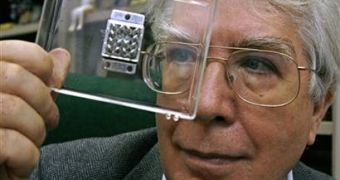Lead is quite a dangerous material, but it's worse without it. Its absence in electronic devices has ruined missiles and stopped from gadgets to communications satellites and forced nuclear power plants. The cause is to be found in the tiny splinters, called whiskers, that develop by themselves from tin solder penetrating deep inside electronics.
The subsequent short-circuits have induced damages of over $10 billion since they were first observed in the 1940s. They could now induce even more havoc, as the European Union and governments worldwide intend to get rid from electronic devices of the best-known protector, lead. "The EU's decision was irresponsible and not based on sound science. We're solving a problem that isn't and creating a bunch of new ones.", said Joe Smetana, tin whisker expert with French telecommunications equipment maker Alcatel-Lucent SA.
The tin whiskers are usually under one mm long, and look like errant static-charged hairs rooting from the tin. Other metals too develop whiskers, but not so much. The problem is with the whiskers bridge interfering in and separating parts of the increasingly tinier circuit boards and sensitive optics.
The cause is not precisely known, but small quantities of lead added to the tin significantly impede the formation of whiskers. Still, lead can cause behavioral issues, anemia and kidney disease in children, while in adults it rises blood pressure and harms the reproductive organs.
In 2006, UE banned lead from most electronics to avoid its accumulation in the environment from discarded old computers and gadgets. Japan, China, South Korea, Argentina, Australia and the United States intend to do the same.
But the EU rules are regarded by many companies as plummeting the reliability of their products, exposing people to the new dangers. EU has already banned cadmium, mercury and three other toxic chemicals, and pointed out the fact that many types of electronics do not obey this law, like military and national security equipment, medical devices, and servers, data storage computers and telecommunications gears.
Exemptions are also applied when there are no alternatives for the toxic metals, or when replacing the chemicals proves to be dangerous. But this makes it harder to produce the leaded parts. "Over time (the failures) are just going to get worse and worse and worse," said Jim McElroy, executive director of International Electronics Manufacturing Initiative, joining big electronics makers, government agencies and teams involved in tin whisker study. "Even if the military is exempt forever, they will be forced to convert because they can't get the components they want. And that will eventually happen across the board." he said.
The tin whiskers have produced many of NASA's failures. "Last year, for example, NASA engineers testing parts for the space shuttle Endeavour discovered that millions of tin whiskers were causing an electronic box to inaccurately point the shuttle's engine, knocking the rocket's trajectory off-kilter," said Henning Leidecker, chief engineer of the electronic parts office of NASA's Goddard and a tin whisker researcher.
NASA had approved the pure-tin-coated clamps employed for keeping circuit boards in place in the 1980s, before adopting its current rule of introducing a small quantity of lead in its tin pieces. "These whiskers have the potential to destroy missions", Leidecker said.

 14 DAY TRIAL //
14 DAY TRIAL //